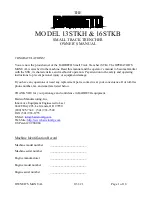
IP-Addressing:
static or DHCP
Enabled Host-to-Host
communication protocols:
•
DNS - Only used as client.
•
DHCP - Only used as client.
•
NetBIOS - Name, Datagram, Session
services, Network files share MS network.
Only used as clinet.
•
Insite ExC - Device servicing by GE
Remote Service.
•
ACR/NEMA Digital Imaging and
Communications in Medicine (DICOM®¹)
○
DICOM Conformance Statement:
http://www.gehealthcare.com/users/
interoperabillity/dicom/products/
ultrasound_dicom.html
○
IHE Integration Statement: http://
www.gehealthcare.com/user/
interoperabillity/ihe.html
Required IT network characteristics
Minimum throughput 100 Mbit/sec, recommended 1Gbit/sec for large image file transfer
Ports open only to Internet:
•
443 - Insite ExC - Service Software - Remote Access
•
443 - Tricefy uplink
Ports open only to secure LAN closed to Internet :
•
53 - DNS Client
•
68 - DHCP Client
•
104 - DICOM (configurable on the system)
•
137, 138, 139, 445 - Netbios/Fileshare
•
514 (UDP), 601 or 6514 - syslog, syslog/TLS (configurable on the system)
•
389 or 636 - LDAP (configurable on the syste)
Ports open to the Internet or local network depending on the configuration :
•
25, 465 or 587 - SMTP (configurable on the system)
•
123 - NTP Client
Listening Ports on the ultrasound system: only to secure LAN closed to Internet :
•
104 - DICOM receive (configurable on the system)
Potential hazardous situations resulting from failures of the IT network
The following general hazardous situations have been identified as potentially arising as a
result of the IT network failing to provide the required characteristics specified above:
•
Delayed or impaired access to images or other exam information or patient data.
•
Permanent loss of images or other exam information or patient data.
•
Corruption of images or other exam information or patient data.
In addition to the hazardous situations identified above, connection of the Voluson™ SWIFT /
Voluson SWIFT+ to a network that includes other equipment could result in other unidentified
risks to patients, operators or third parties. The responsible organization should identify,
analyze, evaluate and control these risks on an ongoing basis including after changes to the
Safety
Voluson™ SWIFT / Voluson SWIFT+ Instructions For Use
5831612-100 Revision 4
2-27
Summary of Contents for Voluson Swift
Page 343: ......
















































